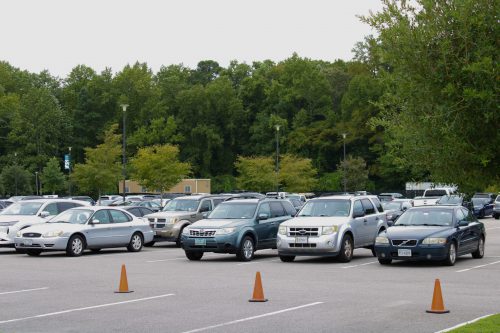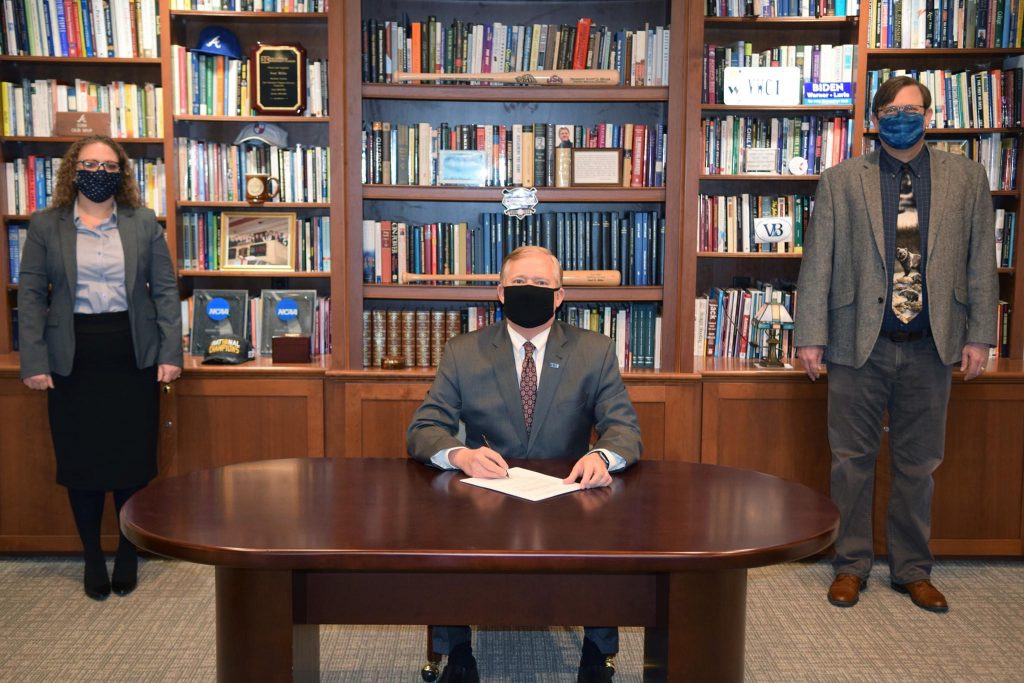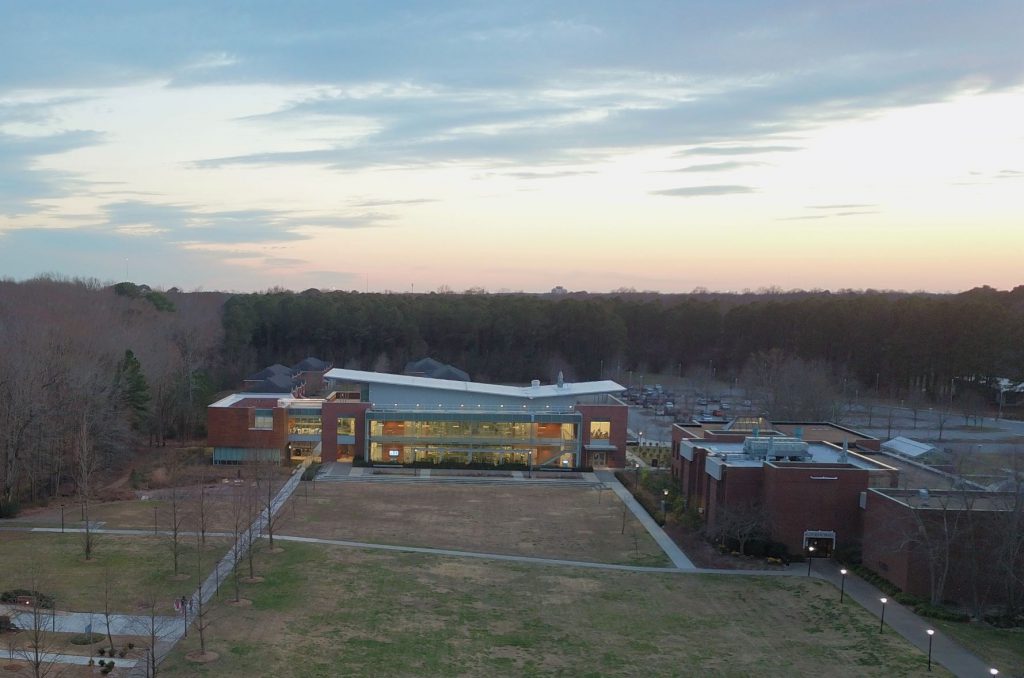McKenna Howenstine|Marlin Chronicle
The Susan S. Goode Fine and Performing Arts Center parking lot on Founders’ Day, Sept. 5, which was asked to be cleared of vehicles for the event.
Largely regarded for years as a “hidden gem” of Virginia Beach for its diverse and thought-provoking works, the Virginia Museum of Contemporary Art (MOCA) is working in collaboration with Virginia Wesleyan to relocate through the creation of a facility on campus.
The new facility will provide around 20% more exhibition space than the previous facility, a substantial improvement for such a comprehensive museum. Such an increase allows the museum to bring in more works, more perspectives and garner further acclaim.
This is an impactful step forward in their mission to increase accessibility to art and art education, and will open the new MOCA facility to a wider audience. The current location of the museum only has around 468,000 people within its 35 mile radius, while the new facility at Virginia Wesleyan has around 1.6 million in the same radius.

Isaac Fick|Marlin Chronicle
Photo of Construction Happening
Along with a larger population, the new facility is closer to more schools, opening up many opportunities for younger audiences to be introduced to the world of contemporary art. President of Virginia Wesleyan Scott Miller particularly emphasizes the importance of the museum’s proximity to more schools.
“When K-12 schools — public and private — plan field trips, transportation logistics like busing and mileage play a critical role in what gets approved. By relocating Virginia MOCA to our more central campus, we shift the conversation around arts exposure and education for children in our region, making it more accessible and impactful for future generations,” Miller said.
Many faculty members are excited about the introduction of the museum to the university. Dr. Travis Malone, professor of Theatre and dean of the Batten Honors College, is “so ecstatic” to hear about its construction. “It will elevate our exposure to the community, to the region, and will give our students an opportunity to interact with world-class artists,” Malone said.

Isaac Fick|Marlin Chronicle
This collaboration is regarded as an enhancement to the already-strong liberal arts culture at Virginia Wesleyan and strives to further broaden the horizons of the university’s students. “As a nationally recognized liberal arts college, the addition of Virginia MOCA to our campus further reinforces our commitment to that distinction, enhancing both our academic environment and cultural presence,” Miller said.
“A liberal arts education is about nurturing the whole person, encouraging critical thinking, creativity and personal growth,” Miller said.
“The arts enrich this experience, offering inspiration and insight in ways few other disciplines can, while deepening our understanding of ourselves and the world around us,” Miller said.
In addition to the increased access to a new world of various art installations and unique exhibits, students can expect opportunities for career advancement and professional development.
“It is the plan that students can expect internships or work opportunities,” Malone said. “We have a number of art majors [who] will be able to do internships and work directly with world-class artists here on campus without having to go around the world. You can begin that art journey and your creative work right here rather than having to seek it elsewhere.”
Despite the optimism of the staff surrounding the construction of the museum, many students are beginning to have various concerns about what the future of the museum holds, especially in terms of student parking options and campus security. “The campus is difficult enough to secure as it is, with all students and off campus organizations using our space. It is a constant flow of people from the local area. Now we have a main attraction for the state to consider as well,” graduate student Rowan Stuart said. “I am not sure how they intend to do security… I don’t expect [them] to be able to coordinate with another independent team to guarantee the same safety we are accustomed to.”
Stuart underscored the critical need for accessible parking for students. “Our parking in relevant spaces [is] already stretched, and we cannot reasonably anticipate the limitation of patrons to the Goode lot,” he said.
Stuart highlighted the impact on residential students in particular: “This campus is a home; you wouldn’t park a mile away from your house in the rain and be expected to walk the distance because someone parked in your driveway.”
Despite student concerns about security and parking, Miller and Malone emphasized that the potential benefits of the museum surpass any temporary inconvenience of the installation.
“The minor inconvenience of having to walk the extra two minutes from Allen Village or the Honors Village parking lot is nothing compared to the benefits we’re getting from this project,” Malone said. “The construction location is in an area already designated for future development,” Miller said. “It was considered surplus parking, pending the construction of a new building.”
Additionally, Miller reinforced VWU’s commitment to student safety. “The DeFord Gatehouse will continue to ensure the safety of the campus by monitoring all visitors,” Miller said. “Museums of contemporary art most frequently attract a particular type of audience that is easy to monitor,” he said, largely citing students from nearby schools as the prime example.
This collaboration between the MOCA and Virginia Wesleyan was a largely unanimous decision from many of the sponsors and supporters behind both organizations. President Miller discussed how philanthropists like Jane Batten, Joan Brock and Susan and David Goode “rallied behind the idea.” Miller boasts that this project is “truly a win-win-win.”
“It’s a win for VWU, offering our students exposure to contemporary art, while providing opportunities in nonprofit and arts management. At the same time, it opens our beautiful campus to the wider public,” Miller said.
“It’s a win for Virginia MOCA, allowing them to expand their exhibit space and advance their mission of arts education in a brand new facility. And it’s a win for the City of Virginia Beach, as the new location…[makes] it more accessible to guests from across Coastal Virginia and beyond,” he said.
The new facility on campus is expected to expand student opportunities and include new perspectives for the campus population.
By: Avery Belisle


